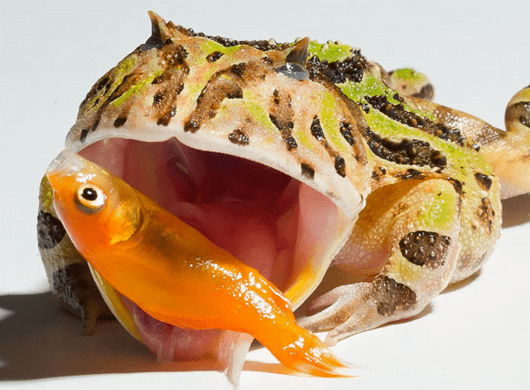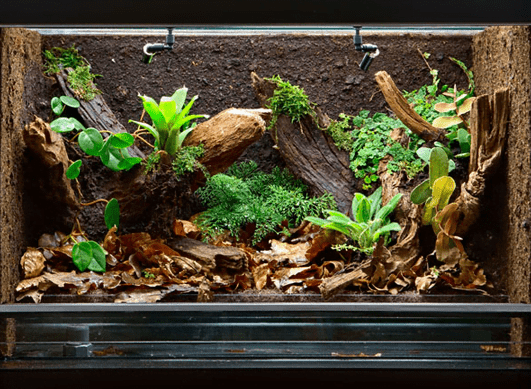The Pacman frog is one of the weirdest species of frogs in the world. Together with Budgett’s frogs, they are the most popular pets in the market. So, what’s special about this species? In this article, we’ll go over 9 facts about Pacman frogs.
Phylum: Chordata
Class: Amphibia
Order: Anura
Genus: Ceratophrys
1. They get their name from the video game character
Pac-man is a yellow video game character who eats everything on the way with a big open mouth. This behavior is similar to that of the Ceratophyrs species. This creature uses its large mouth to consume anything that moves around it. That’s why it is called the Pacman frog.

Besides the name Pacman, these species also come with the name South American horned frogs. This is because they have horns above their eyes and live in South America. Those horns are not true horns comprised of bone; they are actually skin flaps that protrude over their eyes. This feature is very helpful for the frogs’ concealment since they resemble leaf stalks blowing in the wind.
2. Pacman frogs’ natural habitat
Pacman frogs are classified into eight species, all of which belong to the genus Ceratophrys. They are Brazilian horned frog (aurita), Cranwell’s horned frog (cranwelli), Stolzmann’s horned frog (stolzmanni), Colombian (calcarata), Joazeiro (joazeirensis), Ecuador (testudo), Surinam (cornuta), and Argentine horned frog (ornata). All of them have a wide mouth and a similar body form.
These frogs can be found in the lush tropical rainforests, marshlands, and meadows of Bolivia, Colombia, Peru, Paraguay, Ecuador, Brazil, Argentina, Venezuela, and Uruguay.

The Pacman frogs live in different habitats. Some (like the Brazilian horned frog) dwell in subtropical and tropical climates, wet lowland forests, lakes, and freshwater or intermittent swamps. The others (including Venezuelan and Caatinga horned frog) live in arid areas like savanna subtropical or tropical dry shrublands, meadows, valleys, and freshwater swamps.
3. They have an amazing camouflage skill
As mentioned above, the bodies of all eight Pacman frog species are similar. They are rounded and have short legs, making them awful at jumping. In addition to the giant body, South American horned frogs also own an unusual board mouth. Their jaws are strong and are as huge as their heads.
There are multiple colorful patchy markings on their skin. They can be a different combination of beige, green, pink, red, brow, or yellow. Together, they create different shades of colors, such as strawberry pineapple, orange, brown, coffee, chocolate fantasy, chocolate mint, samurai blue, rainbow, green emerald, mutant translucent, camo, peppermint, matcha, apricot, sunburst, etc.
Basically, the Pacman Frog will have a background color with patches of deeper hues on its body. The male typically has spots down its back.
You can see some of their color morphs in the pictures below!

These frogs enjoy burrowing in cool mud or staying amid the leaves on the forest ground, to wait for the prey and hide from predators (birds, bears, and snakes). Their coloration and patterns create a perfect camouflage for them to do this. The male frog fluctuates from dark green to a lime tint, whilst the female is tanner to fit in with the dead leaves.
Males are generally more colorful than females, while females are 2 times larger than males, as well as other typical frogs. The adult size of male South American horned frogs is roughly 2 – 4 inches long, while the full size of females is between 4 – 7 inches long.
The difference in size between them explains why the females always want to consume the males. It’s also the most common technique to tell Pacman frog’s gender.
You may read some of the other Popular Exotic Pet articles for more information:
4. Pacman frogs are well-adapted to the environment
South American horned frogs have their own method to adapt to environment changes. If the environment is too damp, its sticky skin prevents it from decomposition and infection. If the surroundings become dry and cold, or there’s not enough source of food; it hibernates.
The Pacman frog protects itself with a tough hard external skin layer. In the dormancy process, it sits absolutely still and reduces its metabolism. This one-of-a-kind system keeps their inner skin moist. When conditions are appropriate, it sheds the outer hard layer and continues eating and mating.
5. They spend most of their time eating
With a ravenous appetite, Pacman frogs eat all the time. They spend the majority of their time camouflaging and waiting for prey to ambush them. These species will consume anything that passes by their hiding area. In the wild, their diet includes lizards, reptiles, mice, insects, mealworms, superworms, fish, other frogs, and anything else that can fit their large mouth.
They are also well known for being cannibalistic, meaning they can feed on their own kind. With the double size, it’s usual for the female to try to eat the male after breeding, like a praying mantis. Although it’s not uncommon, there are still some cases in which the male tries to consume the female.

Pacman frogs are nocturnal, they’re most active at night and sleep during the day. Thanks to the fairly decent night vision, these creatures can attack other prey that moves around them. To catch the prey, Pacman frogs use their sticky tongues to drag their prey into their huge mouths. Any living thing that comes close enough to be grabbed will be consumed right away.
They can propel themselves with a length of 2-3 times their body to catch the larger prey. Their muscular legs allow them to practically launch their mouths at anything that crosses their way.
Despite having powerful teeth and jaws, as well as a high bite force, they do not chew their prey. Instead of that, they consume their victim entirely, even though they are bigger than them. It is reported that Pacman frogs suffocated themselves when attempting to do this.
6. They are one of the only frogs with teeth
Pacman frogs are the only frogs that have both Maxillary and Vomerine teeth. These teeth, along with bony protrusions function as prison bars employed to lock the prey in their mouth. Their teeth are also used to bite when the frogs are frightened or starving. The bite is not poisonous but it can be painful! Moreover, they can suck your blood. You should be careful when feeding or touching them.

You can share this “Pacman frog facts” infographic on your site
7. They reproduce internally before laying the eggs
In the wild, Pacman frogs’ mating season takes place in the rainy season.
To reproduce, most female amphibians will deposit eggs in the water and depart. The males will then come and fertilize them. However, the Pac-Man frogs don’t follow these rules. They reproduce sexually by fertilizing the eggs directly inside the females.
Similar to other frogs, the Pacman frogs need freshwater to reproduce. After mating, the female seeks a wet area to lay her fertilized eggs. The female lays approximately 2,000 eggs each day. The size of brood can be bigger with 2,500 eggs or more. Not all of these eggs can survive. They can be killed by fish or other aquatic organisms.

Within two weeks, the eggs hatch, and tadpoles arise. Tadpoles are also carnivorous and cannibalistic, and they will prey on each other if there is an opportunity. In just a few weeks, they develop quickly and become little froglets.
These juvenile frogs eat various diets, such as fish, worms, insects, and other creatures. Depending on the food, they can reach maturity after 1 year or even 3 – 4 years. Their lifespan expectancy is approximately between 3 – 7 years. But they can live longer in captivity, about 15 years.
8. The male is much noisier
The Pacman frogs communicate by quacking, squeaking, chirping, and, on rare occasions, yelling. About six months after birth, they start to croak.
Male frogs croak for different reasons. They can croak because of the availability of food or when eating. They can even croak to frighten enemies or just to respond to the noise. In breeding season, they use all their sounds to attract females. They can shout, squeak, croak, or chirp. You can hear Pacman frogs’ mating call on the video here:
On the other hand, the females are more quiet. They barely make noise and choose to do things quietly, when feeding or waiting for a mate.
9. You can keep them as pets
Pacman frogs make great pets, particularly for individuals who enjoy exotic species. Among 8 Pacman frog species, the Argentine horned frog (ornated horned frog) is the suitable choice for those who first take care of a frog.
These frogs adapted well in captivity, they are easy to look after and feed. Pacman frogs can eat anything from pet stores.
You can easily buy them from pet shops or breeding centers. The average Pacman frog costs you between $15 to $30. For the rare color versions like pastel, albino, or teal, the Pacman frog price can be higher, from $40 to $80.

Before getting a South American horned frog, you should remember a few things:
– Tank setup: A tank for Pacman frog have to be big enough, at least 10 gallons. You should put in the tank enough leaf litter, plants, a bowl of water, and substance covering the bottom. The substance has to be moist but not soggy, coconut fiber is the best substrate for the frog.
– The temperature of the enclosure should be between 70 – 80oF, while the humidity level is bout 70 – 80%.
– You should feed Pacman frogs a variety diet if possible, such as earthworms, crickets, roaches, etc. If you have a growing frog, it needs to be fed every day. With an adult one, you can feed them every other day. Because it has a tendency to bite at times, you should use chopsticks or tongs to feed them.
– Touching this Pacman frog is not recommended. As we noticed previously, this frog can bite and draw your blood. Another reason is their skin is extremely sensitive; it is quickly irritated and absorbs toxins.

They can get skin irritation, serious injury, or respirative obstruction due to the oils, perfume, or lotion on your hands. It is critical to wash your hands before handling the Pacman frog.
– Never let 2 Pacman frogs live together or keep your Pacman frog in the same tank with other animals. This is because the Pacman frogs are very aggressive and one of them will be eaten. It is preferable to hold them apart to keep them as well as other animals safe.
Pacman Frogs live a rather long time in captivity. With proper care and maintenance, it will live with you as long as a dog does.

